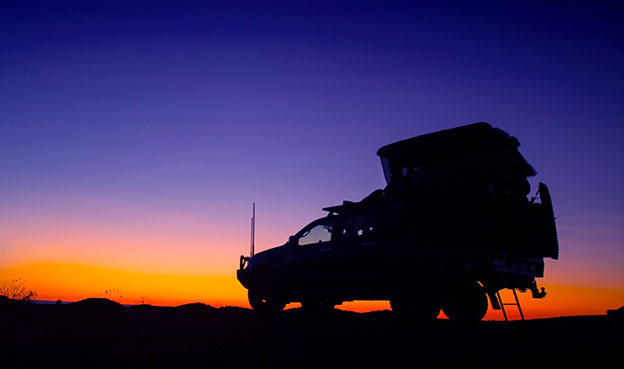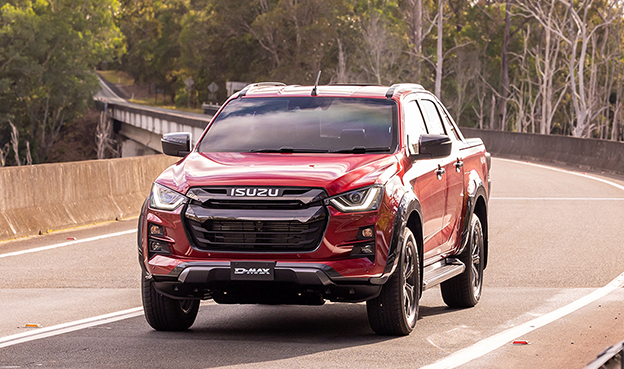

Talk about living the dream—in my nine-to-five, I’m privileged to test drive the latest fourbies to hit the market for Unsealed 4x4, one of Australia’s leading 4x4 publications. So, when I received an invite to attend one of Isuzu’s I-Venture Club 4x4 training events to drive the 2024 Isuzu D-MAX and MU-X range through the Flinders Ranges, I immediately packed a bag. While I’ve had plenty of seat time in the 2024 D-MAX range at the recent media launch, I really wanted a bit of time with the new (for Australia) 1.9L powered 2024 MU-X. Owing it to my readers, I grabbed the keys to the MU-X, which doubled-duties as the camera support car—tasked with lugging hundreds of kilos of precious camera equipment and crew members up and down the ranges. A task I was happy to handle, if I’m honest, as it meant we would claw our way to the front of the convoy and not have to eat dust for a week. Maybe I’m not as silly as I look.
This was also apparently of great assistance to the team, meaning they wouldn’t have to run up a hill, film everyone, run back down the hill with expensive and heavy camera gear, and then drive the MU-X to the next spot, to do it all over again. It also meant a constant supply of snacks, energy drinks, and mindless banter. You know, the road trip essentials…
You see, the camera crew car (in this case, a 2024 1.9L powered 4x4 MU-X LS-U) is the hardest-working vehicle on any trip. Loaded with three big lads, heavy cases packed with cameras, lenses, flashes, and all sorts of amazing technology, which they use to create the content we do, for you—the wonderful audience.
Often the camera car is the last vehicle to leave a spot and needs to overtake the entire convoy of 14 other Isuzu 4x4s, through narrow and overgrown trails, to then park up and set up at the next location to capture the next shot of everyone driving past what we just manoeuvred through. This vehicle was worked hard. Really hard. Both on- and off-road too, I might add. Shaley untrodden terrain, with no mobile reception should we find ourselves stuck either before or after the convoy. This was a proper test over four days in the Flinders Ranges don’t forget.

So, my thoughts on the pint sized performer? On-road you can initially notice there isn’t the same sort of power in the 1.9L MU-X compared to the iconic and torquey 3.0L 4JJ3. But that kind of goes without saying, it’s a smaller motor that makes less power than its bigger brother, but equally it consumed less fuel too. Where everyone was topping up 60-litres or so at the servo in Wilpena, we would only need to top up 50-or-so litres.
What was also equally impressive, was the fact I quickly forgot I wasn’t driving the MU-X with the bigger engine. Sure, the steering was lighter due to the absence of weight across the front axle, but the lighter feel wasn’t any less communicative, it was just more enjoyable, particularly after a long day. Even packed to the rafters with camera equipment and hard-working videographers jumping in and out all day to climb trees and capture pixels, or whatever they do, we were able to push past the convoy when required. Safely and easily.
Another interesting point is the 1.9L powered Isuzu MU-X LS-U can carry more gear, thanks to its higher payload capacity. Which we certainly appreciated. 75kg more to be precise, or an extra adult when you think about it. So, it can carry more weight, consumes less fuel and it keeps up with the pack without issue. I can see how this vehicle will make total sense for fleet buyers, as well as urban commuters looking for a cheaper daily driver.

Off-road, with low-range 4x4 selected, the 1.9L powered MU-X was in its happy place. Thanks to the superb gearing reduction found in the Isuzu’s transfer case, the motor was able to sit in the sweet spot of its rev band—delivering torque on demand—essential for crawling over the undulating terrain. Keep it on song, and the 1.9L doesn’t struggle.
All of that torque would’ve been wasted if it wasn’t for the MU-X's suspension flexibility, ensuring at least three, and sometimes, two wheels were planted in the dirt. With the wheels scrambling for traction—with sometimes one or two in the air—the MU-X's clever Rough Terrain Mode earned its keep by ensuring torque was sent to whichever wheel had the surest footing. When the climbs got steeper and the terrain looser, it was all about mechanical grip and technique—the latter I am still trying to perfect despite my years of experience—but, with tyres deflated to 18-psi and the Rear Diff Lock engaged, I found that the MU-X capably clawed and clambered its way through everything.

Given that it was a borrowed vehicle, I was initially apprehensive of the clearance, but that quickly found faith in the effective departure angles found in the MU-X, which are better compared to its ute-based sibling. Even in the demanding off-road settings found in the Flinders Ranges, including the breathtakingly steep climb of the fabled Wowee Track and soft red sands of the desert, it performed remarkably well with little complaints.
That’s the thing you find about working closely with the camera crew—they are an honest bunch. The feedback I received when they jumped back in the vehicle, wasn’t “well-driven mate.” It was, “I can’t believe you drove through that first go, and how good is the clearance!” Which I guess is of much as a compliment as one could ask for from the camera crew…
Want to know more about the 1.9L MU-X? Explore the 1.9L MU-X Range.





